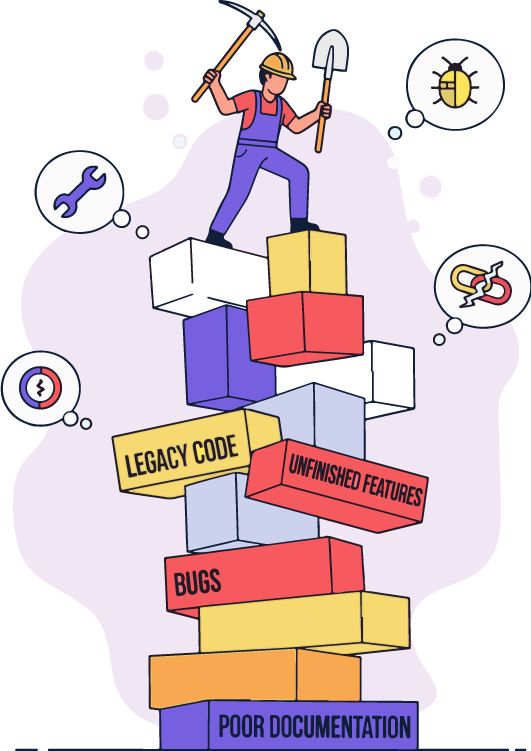Now Reading: Agile Backlog Refinement: Tackling Technical Debt Case Study
-
01
Agile Backlog Refinement: Tackling Technical Debt Case Study
Agile Backlog Refinement: Tackling Technical Debt Case Study
How “Legacy Systems Corp.” balanced new feature demands with a critical need to address mounting technical debt.
The Challenge: The Silent Killer of Productivity
Legacy Systems Corp. had a successful, mature product, but years of rapid development had created a hidden problem: significant technical debt. New features were becoming painfully slow to build, the number of production bugs was creeping up, and developer morale was dipping. “It feels like we’re running in quicksand,” a senior developer commented during a retro. The business stakeholders, focused on new revenue and competitive features, were hesitant to dedicate entire sprints to non-visible “cleanup” work. The team desperately needed a way to articulate the risks and plan a balanced, strategic approach.
The Solution: Making Invisible Work Visible and Compelling
The Scrum Master initiated a refinement session using the Agile Backlog Refiner to translate the abstract concept of “tech debt” into concrete business risks and actionable work.
- Formalizing Debt as an Epic (Step 2): They created a dedicated epic called “Platform Stability & Refactoring” alongside their usual feature-based epics like “New Reporting Module.” This simple act formally acknowledged tech debt as a first-class citizen in the backlog, deserving of proper planning and prioritization.
- Quantifying the Debt (Step 3): They broke the epic down into specific, tangible PBIs: “Upgrade Outdated Logging Library,” “Refactor Monolithic Payment Module,” and “Add Indices to Slow Database Tables.” They added initial story point estimates to each, quantifying the effort required.
- Connecting Debt to Business Value (Step 5): This was the game-changing step. The team moved to the Risk Assessment tab. For the new “Advanced Reporting” PBI that sales was demanding, the developers added a critical risk: “High risk of slow performance and timeouts due to inefficient database queries.” The mitigation strategy? “Complete PBI ‘Add Indices to Slow Database Tables’ before starting this feature.” Suddenly, the cost of not addressing the tech debt was explicitly tied to the success of a revenue-generating feature.
- Negotiating a Balanced Sprint (Step 6): In the sprint planning view, the Product Owner could now make an informed, data-driven decision. The argument was no longer “we need time for cleanup.” It was “to ensure the new reporting feature is fast and reliable, we must allocate 8 points to this foundational database work.” They allocated approximately 20% of the team’s capacity to PBIs from the “Platform Stability” epic, with full buy-in from stakeholders.

The Outcome: A Sustainable and Healthy Backlog
The visual and structured nature of the tool facilitated a crucial, constructive conversation between the development team and business stakeholders.
Shared Understanding of Risk: Business stakeholders could now clearly see the direct impact of tech debt on their strategic goals. Their perspective shifted from viewing it as a “cost center” to a necessary “investment in future speed.”
Strategic Debt Reduction: Instead of randomly fixing old code, the team now prioritized the tech debt that posed the greatest risk to their immediate roadmap, maximizing the impact of their refactoring efforts.
Improved Velocity Over Time: After two quarters of consistently dedicating a portion of each sprint to this work, the team’s velocity on new features began to increase. They were building on a more stable and modern foundation, which accelerated all future development.
The Agile Backlog Refiner provided the framework for the team to manage technical debt strategically, creating a more sustainable, predictable, and resilient product development process.
Tool Spotlight: How the Refiner Made the Difference
- Dedicated Risk Assessment (Step 5): This feature was the key. It created a direct, traceable link between a specific piece of tech debt and a specific business-facing feature, making the consequences of inaction impossible to ignore.
- Epic and PBI Structure (Step 2): Treating tech debt as a formal epic allowed it to be planned and tracked with the same rigor as feature work, elevating its importance in the backlog.
- Capacity-Aware Sprint Planning (Step 6): The tool made it easy to visualize and allocate a percentage of the team’s capacity to debt reduction, ensuring a balanced approach that delivered both new value and long-term stability.

